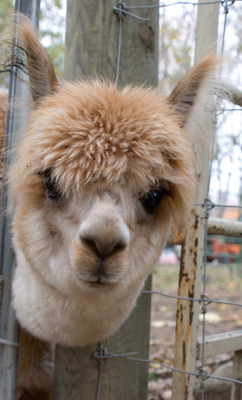|
Semi-Hollow Fiber
Outdoor clothes designers have invested heavily in the development of synthetic semi-hollow fiber. The reason is fairly simple. A hollow core fiber weighs less that the same diameter solid core and because air is trapped in the core, the fabric warms up very quickly. As a result, all outdoor enthusiasts know that apparel made from hollow core fiber tends to be light weight and much warmer than their solid core equivalents. Alpaca is a natural semi-hollow fiber with a fineness that matches many of the micro-fiber synthetics. Unlike synthetically engineered micro-fiber, alpaca is produced by a sustainable process. No animal is killed during the harvest (such as in goose down) and the alpaca fiber industry is environmentally friendly. It even stays warm when it is wet.
Moisture Wicking
It is really difficult to walk into any outdoor shop today and pick up a product that is not advertising moisture wicking properties. Wicking and absorbing moisture are two different things. Absorbing moisture is what a sponge does. It keeps taking in moisture until it becomes saturated and the whole sponge feels wet. Wicking is when the fabric transports moisture away from its source to the outside of a fabric where it is able to evaporate. Wool and cotton are very absorbent but do not have very good wicking properties, which is why many people complain that their feet sweat or feel wet in wool or cotton socks. Alpaca on the other hand, has low moisture absorbency with great wicking properties resulting in better comfort and warmth.
Hypoallergenic
Unlike wool, alpaca fleece contains no lanolin, and requires no chemical-scouring agents for processing. This, combined with its natural hypoallergenic properties and softness, makes alpaca garments comfortable, even for sensitive skin. The softness of Alpaca over wool of the same micron count is due to a scale height of 0.4 micron for Alpaca versus 0.8 micron for wool. If you compare an alpaca fiber to a wool fiber under a microscope, you will find the surface of the alpaca fiber will be smooth where the wool fiber will appear to have scales. The lower scale height creates a smoother, slippery feel with a less scratchy surface. Alpaca has a much less prickle factor than merino wool of the same fineness due to the flatter scales on the alpaca fiber.
Why North American Alpaca
In the early 1990's, the South American fashion industry placed pressure on farmers to increase production of white fiber. The emphasis on breeding only white animals, overgrazing and poor animal husbandry practices caused the loss of both natural colors and fineness of the alpaca fiber in general. Meanwhile the relatively small North America herd continued to focus on all characteristics of the alpaca which gave it’s fiber luxury status. Above all other world markets, the North American alpaca market is predominately a breeders market where investment quality animals are in high demand. This has resulted in farmers practicing intense selective breeding programs which all but guarantee the superior properties developed in the alpaca over 5000 years ago remains true in North American Alpaca Fiber. |








